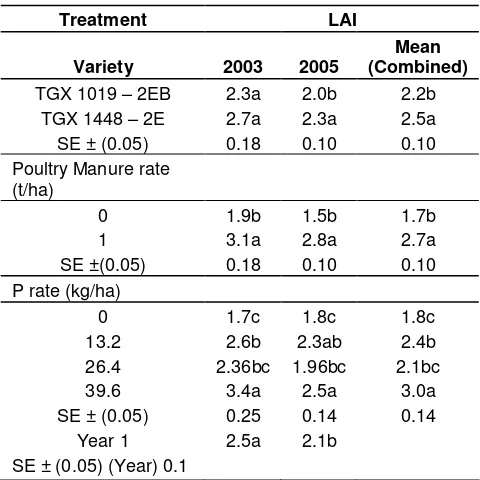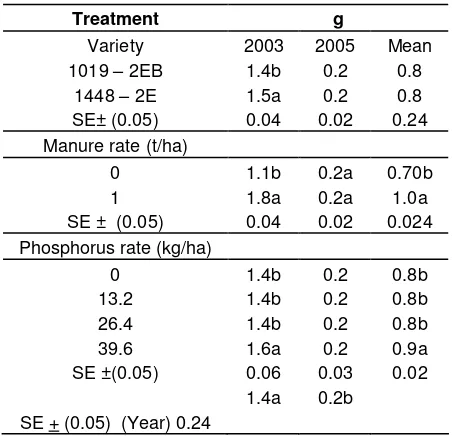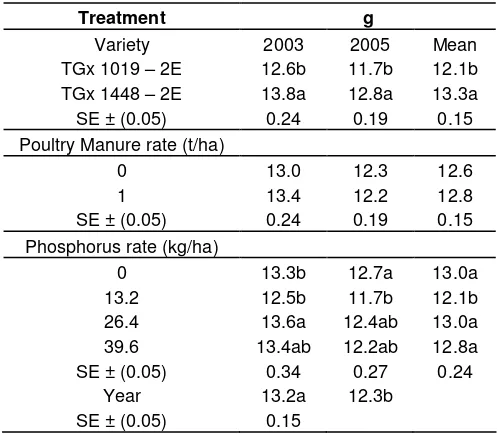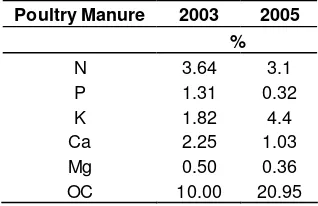Full Length Research Paper
Soybean response to application of poultry manure and
phosphorus fertilizer in the Sub-humid Savanna of
Nigeria
U. F. Chiezey
1and A. C. Odunze
2*
1Department of Agronomy, Ahmadu Bello University, Zaria, Nigeria. 2
Department of Soil Science, Ahmadu Bello University, Zaria, Nigera. Accepted 12 May, 2009
Field experiments were conducted during the rainy seasons of 2003 and 2005 in Samaru in the Northern Guinea Savanna zone of Nigeria to test the response of two soybean varieties to application of poultry manure and phosphorus fertilizer levels. Soybean varieties TGx 1448-2E and TGx 1019-2EB were grown without and with 1t/ha of poultry manure and four levels of P (0, 13.2, 26.4 and 39.6 kgP/ha) in all possible factorial combinations using randomized complete block design with four replicates. TGx 1448-2EB was shorter, had more pods and heavier seeds than TGx 1019-2EB. Grain yield and total dry matter per hectare were higher in TGx 1448-2EB. Application of manure consistently influenced most parameters in both years. Manure application increased leaf area index, plant height, nodule dry weight, total dry matter per plant and per hectare, number of pods per plant and grain yield per hectare. Phosphorus application increased leaf area index, plant height, nodule dry weight, total dry matter per hectare and grain yield per hectare. Highest grain yield was obtained with 26.4 kgP/ha which was not significantly different from yield obtained with 39.6 kgP/ha. Regression model showed a quadratic response and the agronomic optimum was 23.3 kgP/ha for a grain yield of 1.7 t/ha when averaged over both years. Application of 1 t/ha of poultry manure significantly (P<0.05) increased grain yield. Averaged over both years, application of 1 t/ha of manure increased grain yield by 33.7% compared with plots without poultry manure. There were no interactions between poultry manure and phosphorus fertilizers in any of the years or when weighed over the years.
Key words: Soybean, poultry-manure, phosphorus-fertilization.
INTRODUCTION
Soybean (Glycine max L. Merr) production has gained prominence in the Northern Guinea savanna zone stimu-lated by demand for oil and raw material for poultry feed. The total area under production in Nigeria is estimated at 659,000 ha with a total output of 211,000 MT, giving a yield of 320 kg/ha (FA0, 1996). The increase in total out-put has been due to increased land area and not neces-sarily by optimizing agronomic practices. Continuous ex-pansion may lead to degraded environmental conditions, characteristic of tropical soils when continuously brought under cultivation and even with application of fertilizers, yield increases tend to be static over time. Recent studies
*Corresponding author. E-mail: [email protected]. Tel : +2348035722052.
with fertilizers in the Nigerian savanna have shown that soybean responds to P and recommended rates range from 26.4 - 30.1 kg P/ha (Pal et al., 1989; Chiezey et al., 1992). Nitrogen application has proved inconclusive and yields have rarely been increased with N application, par-ticularly on soils with adequate strains of rhizobia (Rad-ley, 1968) as most tropical soils have adequate strains that induce nodulation in soybean (Pulver et al., 1985)
Table 1. Rainfall Data for Samaru Zaria, Nigeria: 2003 and of between 20 and 40 t/ha of OM. The problematic aspect of these high rates of organic manure recommendations is the unavailability of such enormous amounts. Peasant farmers operating at subsistence level or slightly above subsistence cannot generate these quantities of OM even for their small plots of less than one hectare. Rather than recommending rates that are not feasible, the emphasis should be the complimentary role of OM in soil health and fertility maintenance, instead of total reliance on OM as source of nutrients. Moreover, apart from unavailability of these high amounts recommended, the quality is also very low due to inadequate storage and handling.
This study was therefore initiated to verify the response of two soybean varieties to application of poultry manure and different rates of inorganic phosphorus fertilizers.
MATERIALS AND METHODS
Field experiments were conducted for two years; 2003 and 2005, in the research farm of the Institute for Agricultural Research (IAR) Ahmadu Bello Univeristy, Samaru (11° 11’N, 7° 381E) 686 m above sea level. Samaru is located in the Northern Guniea Savanna with an annual rainfall of 1100 mm distributed between April and Octo-ber (Kowal and Knabe, 1972). The objective of this experiment was to test the response of two soybean varieties (TGx1448-2E and TGx 1019-2E) to two levels of poultry manure (0 and 1 t/ha) and four levels of P (0, 13.2, 26.4 and 39.6 kg P/ha) in all possible facto-rial combinations using a randomized complete block design with four replications and plot size of 4.5 m wide and 4 m long (18 m2).
The net plot size was 2 m X 4.5 m (9.0 m2)
Soil samples were collected from each experimental site before fertilizer application and analysed for physico-chemical properties (IITA, 1991). Similarly, the poultry manure was analysed for the nutrient content. Meteorological data for the years of study were obtained at the IAR meteorological station.
Soybean varieties TGX 1448-2E and TGX 1019-2E released by
the International Institute of Tropical Agriculture (IITA), Ibadan, Ni-geria were drilled on 75 cm ridges at a population of 300,000 plants per hectare. Two levels of organic matter tested were zero and 1 t/ha using poultry manure collected from a poultry farm in the Uni-versity campus where some staff keep poultry.
Weeds were controlled by spraying all plots with pre-emergence herbicide (Galex) which is a 1.1 mixture of metolachlor and meta-bromuron at 2.25 kg ai/ha immediately after planting. One hoe weeding was subsequently carried out at six weeks after sowing (WAS) to control weeds that later emerged. Ten plants per plot were sampled to determine treatment effects on leaf area index (LAI), number of days to 50% flowering, plant height at harvesting, nodule dry weight per plant, total dry matter per plant and per hec-tare at harvesting, number of pods per plant at harvesting, 100 seed weight and grain yield per hectare. Leaf area was measured using leaf dry weight method (Nangju and Wanki, 1980) at 8 WAS, that is, full bloom. LAI was calculated by dividing leaf area by the land area supporting the plant (Watson, 1952).
Nutrient content of plants was analyzed at full bloom stage. All the data collected were analysed for each year and both years combined using analysis of variance as described by Snedecor and Cochran (1967). Means were compared using the Duncan Multiple range test as described by Duncan (1955) at 5% level of signify-cance. Regression analysis was done as described by Snedercor and Cochran (1967). Optimum P rate was determined using the re-gression model:
Y = 1489.0 +6. 2x – 0.133x2 R2 = 93.8%
RESULT
Table 1 shows the rainfall pattern during the cropping seasons of 2003 and 2005. More rain fell in 2003 than 2005 but was evenly distributed in both years to support crop growth. Grain yield was higher in 2003 probably be-cause of more rain which helped solubilise the phos-phate. Table 2 shows the chemical and physical proper-ties of the soils of the experimental areas. While the soil of the 2003 trial was a loam, the site in 2005 was a silty loam. These soils were characteristically low in organic carbon, available N and P. Jones and Wild (1975), Lom-bin et al. (1987) and Odunze et al. (1991) observed that soils of the savanna are inherently low in fertility. Water logging was high in 2005 because of the high silt content and this might have adversely affected nutrient availabi-lity and subsequently resulted in low yield that was expe-rienced.
Leaf area index varied between the two varieties tested (Table 3). TGx 1448-2E had significantly (P<0.05) higher leaf area than TGx 1019-2EB (15%)in 2005 and when averaged over both years. Application of poultry manure significantly (P<0.05) increased LA1 in both years and when averaged over both (58.8%). LAI also increased with increasing P level and the highest LAI was obtained with the highest P rate. When averaged over both years, 39.6 kgP/ha increased LA1 by 66.7% compared with plots without P.
Table 2. Physical and chemical properties of the experi-mental soil of Institute for Agricultural Research Farm, Samaru.
Physical Composition 30 cm depth
Sand (g/kg) 2003 2005
Silt (g/kg) 440 140
Clay (g/kg) 340 640
Textural Class 220 220
Chemical composition Loam Silty Loam
pH in H2O 5.8 6.2 8WAS as influenced by different rates of poultry manure and phosphorus levels in Samaru. same column are not significantly different at 5% levels of signifi-cance using Duncan Multiple Range Test.
and 2005 respectively. When averaged over both years, poultry manure application increased plant height by 16%. Application of phosphorus increased plant height in 2003 and when averaged over both years. The applica-tion of 39.6 kgP/ha increased plant height significantly
Table 4. Mean plant height (cm) at harvesting of two soybean varieties as influenced by different rates of organic manure same column are not significantly different at 5% levels of signifi-cance using Duncan Multiple Range Test.
(P<0.05) by 10.4% compared with plots without P when averaged over both years.
Number of days to 50% flo-wering was similar for both varieties (Table 5). Both varie-ties flowered in 48 days after planting. Neither poultry manure rate nor P application influence-ed number of days to 50% flowering. Rainfall distribution was also better in 2003 than 2005. There were 89 rainy days in 2003 compared with 66 days in 2005. The longer rainy days in 2003 ensured enough moisture during grain filling period. Therefore a combination of adequate rainfall spread over a longer period ensured a higher grain yield in 2003 compared with 2005.
Nodule dry weight did not significantly differ between the two varieties except in 2003 when TGx 1448-2E had a slightly higher nodule dry weight than TGx 1019-2EB (Table 6). Poultry manure application increased nodule dry weight in 2003 and when averaged over both years, dry weight by 12.5% compared with plots without P.
Table 5. Mean number of days to 50% flowering of two soybean varieties at 8WAS as influenced by different rates of poultry ma-nure and phosphorus levels in Samaru.
Treatment No. Days
Means followed by same letter(s) within a treatment group in same column are not significantly different at 5% levels of significance using Duncan Multiple Range Test.
Table 6. Mean nodule dry wt (g) per plant of two soybean varieties at 8WAS as influenced by different rates of organic manure and phosphorus levels in Samaru.
Treatment g
Means followed by same letter(s) within a treatment group in same column are not significantly different at 5% levels of significance using Duncan Multiple Range Test.
hectare differed significantly (P<0.05) between the two varieties (Table 8). When averaged over both years, TGx1448-2E produced 14% more dry matter than TGx
Table 7. Mean total dry matter per plant at harvesting (g) of two soybean varieties at harvesting as influenced by different rates or organic manure and phosphorus levels in Samaru. same column are not significantly different at 5% levels of sig-nificance using Duncan Multiple Range Test
Table 8. Mean total dry matter (kg/ha) of two soybean varieties at column are not significantly different at 5% levels of significance using Duncan Multiple Range Test.
Table 9. Mean number of pods per plant of two soybean varieties at harvesting as influenced by different rates of organic manure and phosphorus levels in Samaru.
Treatment No. of pods/plant
Means followed by same letter(s) within a treatment group in same column are not significantly different at 5% levels of significance using Duncan Multiple Range Test.
Table 10. Mean 100 – Seed wt of two soybean varieties as influenced by different rates of poultry manure and phosphorus le-vels in Samaru. column are not significantly different at 5% levels of significance using Duncan Multiple Range Test.
of poultry manure increased total dry matter per hectare by 31.9%.
Phosphorus application influenced TDM per hectare in 2003 and when averaged over both years. The applica- tion of 26.4 kg P/ha increased TDM per hectare by 37.1% and 20.7% in 2003 and when averaged over both years respectively, compared with plots where no P was applied.
The number of pods produced by the two varieties sig-nificantly (P<0.05) differed (Table 9). TGx 1448-2E pro-duced significantly (P<0.05) more pods in 2003 (12.8%) and when averaged over both years (11.6%) than TGx 1019-2EB. Poultry manure application increased number of pods per plant significantly in 2003 and when both years were combined. Application of 1 t/ha of poultry ma-nure increased number of pods by 35.9% in 2005 and 17.8% when averaged over both years.
The application of P had significant (P<0.05) effect on number of pods produced per plant in 2003 and when averaged over the two years. Application of 39.6 kg P/ha increased number of pods by 75.4% in 2003 and 62.1% when averaged over both years compared with plots without P in both instances. However, there were no sig-nificant (P<0.05) differences in pod number between 13.2, 26.4 and 39.6 kg P/ha. One hundred (100) seed weight varied significantly (P<0.05) between the two va-rieties (Table 10).
TGx 1448-2E seeds were significantly (P<0.05) heavier by 9.5, 9.4 and 9.9% in 2003, 2005 and when averaged over both years respectively than seeds of TGx 1019-2EB. Poultry manure application had no significant influ-ence on 100 seed weight in any of the years and when averaged over both years. Application of P increased 100 seed weight in 2003 with 26.4 kg P/ha producing the heaviest seeds. P effect in 2005 was inconsistent. In 2005, plots without P produced heavier seeds than plots where 13.2 kg P/ha was applied.
Grain yields of both varieties differed significantly (Table 11). TGx 1448-2E yielded 24.9% and 14.0% more grains than TGx 1019-2EB in 2003 and when averaged over the two years respectively. The effect of manure on grain yield was consistent in both years. Grain yield was higher in plots with manure by 36.8% and 29.9% in 2003 and 2005 respectively. When averaged over both years manure application increased grain yield by 33.7%.
Phosphorus application increased soybean grain yield in 2003 and when averaged over both years. Application of 26.4 kg P/ha increased yield by 27.1% and 20.7% in 2003 and when averaged over both years respectively. Yield increased with P application in 2005 but such increases were not significant (P<0.05). There were no significant (P<0.05) increases in yield by increasing P le-vel from 26.4 to 39.6 kgP/ha.
Table 11. Mean grain yield (kg/ha) of two soybean varieties at har-lumn are not significantly different at 5% levels of significance using Dun-can Multiple Range Test.
Table 12. Chemical composition of soybean at 8WAS in 2003.
Treatment variety N% P% K% Ca% Mg% tion of more assimilates. It was also shorter; thereby ex-pending less assimilates for non-productive functions. Both total dry matter, numbers of pods per plant and 100 seed weight were higher in TGx 1448-2E than TGx 1019-
Table 13. Chemical composition of ma-nure samples used in 2003 and 2005 ex-periments.
Poultry Manure 2003 2005
% grain yield of TGx1448-2E. Nutrient content of the two va-rieties were similar except for the N. TGx 1019-2EB had a slightly higher N content than TGx 1448-2E probably because of the genetic makeup.
Influence of organic manure on growth and yield
Parameters such as LA1, plant height, nodule dry weight, total dry matter per hectare, number of pods per plant in-creased with the application of poultry manure. Organic manure is a reservoir of nutrients and these nutrients are released during humification, thus supplying the neces-sary elements for plant growth. The nutrient content of the poultry matter was fair (Table 13), and the quantity applied must have supplied the important nutrients such as N and P which are critical for soybean growth.
Grain yield was increased with the application of poultry manure in 2003 probably because of a more conducive environment in terms of rainfall. Rainfall was heavier and longer in 2003 (1154.3 mm) compared with 884.7 m for 2005. This must have ensured proper decomposition and release of nutrients in the organic matter. Mineralization is generally higher in wet soils than in dry soils.
Effects of phosphorus on growth and yield
Application of phosphorus affected most of the growth and yield parameters. LA1 and plant height were general-ly increased with application of P. These growth para-meters have been shown to increase with P application, indicating the essentiality of P as a nutrient requirement for soybean (Chiezey et al., 1992; Chiezey et al., 1993). The application of P stimulated leaf expansion; hence more light interception for photosynthetic activity and high assimilate accumulation. Number of days to 50% flower-ing remained unchanged with P application contrary to the earlier reports by Chiezey et al. (1992) where P appli-cation increased the vegetative phase. Nodulation incre-ased with P application.
in the plant, particularly grain yield and total dry matter (Pal et al., 1983; Chiezey et al., 1992). Pod yield and 100 seed weight which are important determinants of grain yield increased with P application. These resulted in in-creased grain yield. The response to P application on grain yield was more visible in 2003 because of the low level of P in the experimental soil in 2003 compared with the P level in soils of 2005.
In 2005, the experimental site had about seven times the level of P compared to the soil of 2003; therefore, the response to extra P was minimal. Attempt to determine the optimum P rate using regression model showed the following quadratic relationship for the two years, when averaged over both:
Y = 1489.0 +6. 2x – 0.133x2 R2=93.8%
The response showed that the optimum P rate was 23.3 kgP/ha which was below the 29.6-30.1 kg/ha observed by Pal et al. (1983) and Chiezey et al. (1992). It could there-fore be concluded that application of P not exceeding 23.3 kg /ha or applying 1 t/ha of poultry manure will sig-nificantly increase grain yield of soybean. However, the quality of manure must be taken into consideration as the nutrient supplying power depends on the conditions un-der which the manure was stored.
REFERENCES
Abdullahi A, Lombin G (1978). Long-term fertility studies at Samaru – Nigeria. II. Comparative effectiveness of separate and combined applications of mineral fertilizers and farmyard manure in maintaining soil productivity under continuous cultivation in the savanna. Samaru miscellaneous paper 75: 12.
Aliyu L (2000). Effect of organic and mineral fertilizers on growth, yield and composition of Pepper (capsicum amum L.). Biol. Agric. Horti. 18:29-36.
Barreto PD, Dynia JF (1988). Monocropping systems in the Brazilian semi arid Tropics In: Earl Engene Watt and Joao Pratagil Pereira de Aranjo. Cowpea research in Brazil IITA, Ibadan Nigeria.
Chiezey UF, Yayock JY, Shebayan JAY (1992). Response of soybean
(Glycine max (L) Merrill) to nitrogen and phosphorus fertilizer levels. Tropical Sci. 32: 361-368.
Chiezey UF, Yayock JY, Ahmed MK (1993). Growth and development of soybean as influenced by phosphorus fertilizer and plant density. Crop Res. 6(3): 341-349.
Duncan DB (1955). Multiple range and multiple tests Biometrics 11:1-42.
EzeakunneCO (1985). The effect of nitrogen and phosphorus fertilizers and farmyard manure on growth and yield of local garden egg (Sola-nam gilo) variety Samaru striped’. Unpublished MSc Thesis, Ahmadu Bello University, Zaria p.109
FAO (1996). Food and Agriculture Organization of the United Nations Production Yearbook.
Jones MJ, Wild A (1975). Soils of the West African Savanna: Common-wealth Agricultural Bureaux Technical Communication 55: 246 Lombin G (1987). Fertilizer requirements of the major cereal crops in
the Nigerian Savanna. Paper presented at the National fertilizer Seminar in Port-Harcourt p. 50
Nangju D, Wanki BC (1980). Estimating leaf areas of cowpea and soybean by dry weights of terminal leaflets. Exp. Agric. 16: 149-151 Odunze AC, Chude VO, Adeoye KB (1991). Physico chemical
Pro-perties and Management of Alfisols in the Nigerian Savanna. Organi-zation of African Unity (OAU). J. Afr. Soils/Soils Afr. Tech. Res. Comm. Lagos. 24: 20-38.
Pal UR, Olufajo, Nnadi LA (1989). Response of soybean (Glycine max
(L.) Merrill) to phosphorus, Potassium and Mdybdenum applications. J. Agric. Sci. Cambridge 112:131-136.
Pulver EL, Kueneman EA, Ranga RV (1985). Identification of promis-cuous modulating soybean efficient in N2 fixation. Crop Sci. 5:660-663
Radley RW (1968). The prospects of soybean production in Trinidad and Tobago. J. Agric. Soc, Trinidad and Tobago 68:165.
Snedecor GW, Cochran WG (1982). Statistical methods. Iowa Univer-sity Press Ames.




